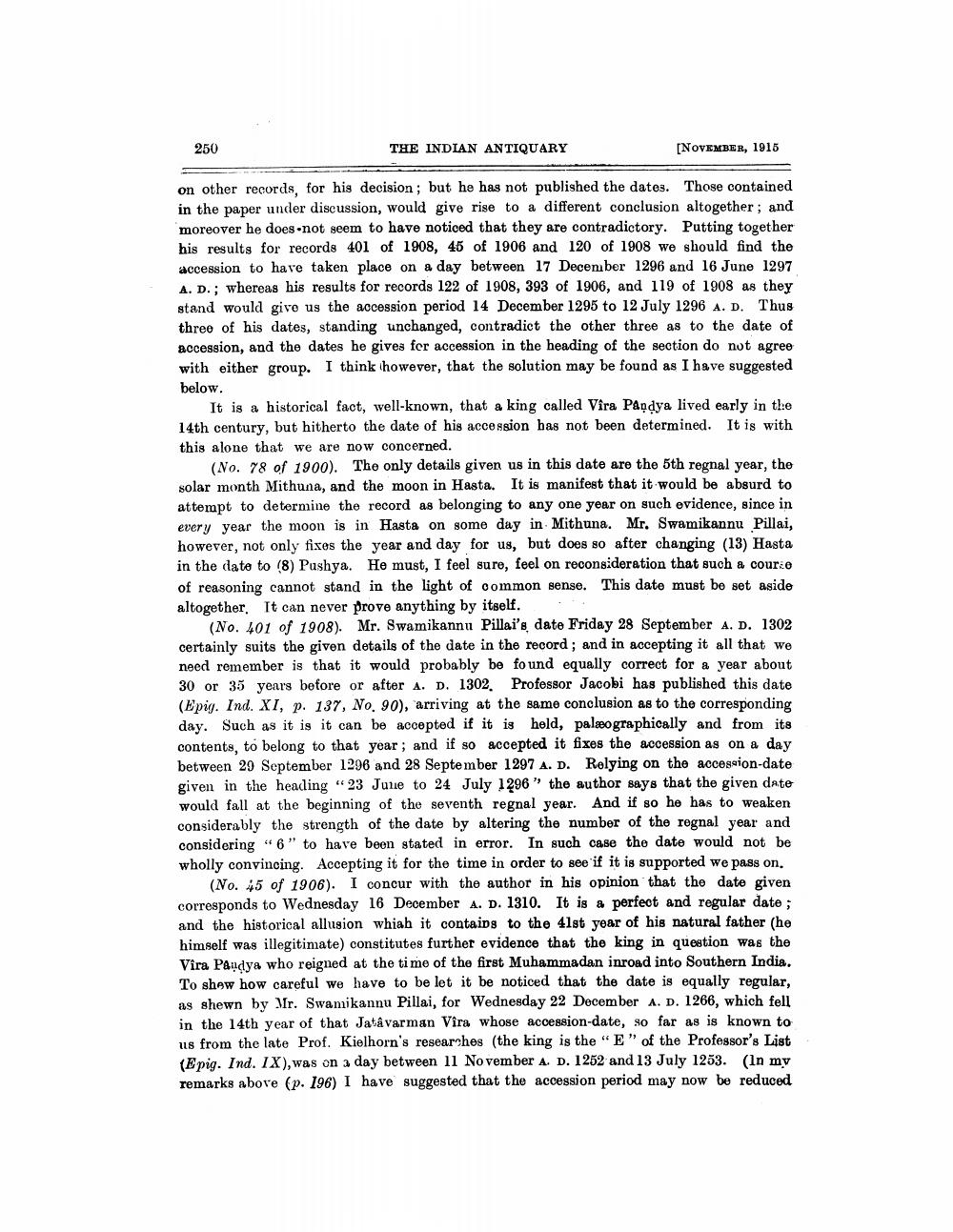________________
250
THE INDIAN ANTIQUARY
[NOVEMBER, 1915
on other records, for his decision; but he has not published the dates. Those contained in the paper under discussion, would give rise to a different conclusion altogether; and moreover he does not seem to have noticed that they are contradictory. Putting together his results for records 401 of 1908, 45 of 1906 and 120 of 1908 we should find the accession to have taken place on a day between 17 Decenı ber 1296 and 16 June 1297 A. D. ; whereas his results for records 122 of 1908, 393 of 1906, and 119 of 1908 as they stand would give us the accession period 14 December 1295 to 12 July 1296 A. D. Thus three of his dates, standing unchanged, contradict the other three as to the date of accession, and the dates he gives for accession in the heading of the section do not agree with either group. I think however, that the solution may be found as I have suggested below.
It is a historical fact, well-known, that a king called Vira Pandya lived early in the 14th century, but hitherto the date of his accession has not been determined. It is with this alone that we are now concerned.
(No. 78 of 1900). The only details given us in this date are the 5th regnal year, the solar month Mithuna, and the moon in Hasta. It is manifest that it would be absurd to attempt to determine the record as belonging to any one year on such evidence, since in every year the moon is in Hasta on some day in Mithuna. Mr. Swamikannu Pillai, however, not only fixes the year and day for us, but does so after changing (13) Hasta in the date to (8) Pushya. He must, I feel sure, feel on reconsideration that such a courie of reasoning cannot stand in the light of common sense. This date must be set aside altogether. It can never prove anything by itself.
(No. 401 of 1908). Mr. Swamikannu Pillai's date Friday 28 September A.D. 1302 certainly suits the given details of the date in the record ; and in accepting it all that we need remember is that it would probably be found equally correct for a year about 30 or 35 years before or after A. D. 1302. Professor Jacobi has published this date (Epig. Ind. XI, p. 137, No. 90), arriving at the same conclusion as to the corresponding day. Such as it is it can be accepted if it is held, palæographically and from its contents, to belong to that year, and if so accepted it fixes the accession as on a day between 29 September 1296 and 28 September 1297 A. D. Relying on the accession-date given in the heading " 23 June to 24 July 1296" the author says that the given date would fall at the beginning of the seventh regnal year. And if so he has to weaken considerably the strength of the date by altering the number of the regnal year and considering "6" to have been stated in error. In such case the date would not be wholly convincing. Accepting it for the time in order to see if it is supported we pass on.
(No. 45 of 1906). I concur with the author in his opinion that the date given corresponds to Wednesday 16 December A. D. 1310. It is a perfect and regular date; and the historical allusion whiah it contains to the 41st year of his natural father (he himself was illegitimate) constitutes further evidence that the king in question was the Vira Paudya who reigned at the time of the first Muhammadan inroad into Southern India. To show how careful we have to be let it be noticed that the date is equally regular, as shewn by Mr. Swamikannu Pillai, for Wednesday 22 December A.D. 1266, which fell in the 14th year of that Jatavarman Vîra whose accession-date, so far as is known to us from the late Prof. Kielhorn's researches (the king is the "E" of the Professor's List (E pig. Ind. IX),was on a day between 11 November A. D. 1252 and 13 July 1253. (In my remarks above (p. 196) I have suggested that the accession period may now be reduced




